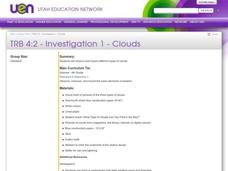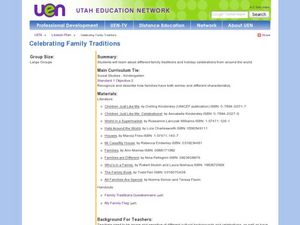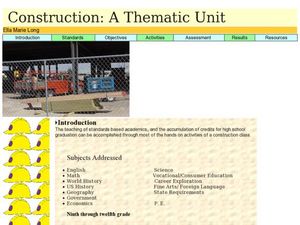Curated OER
Clouds
Students observe and record different types of clouds. They use a cloud chart to discuss the three cloud types to see if students can identify the clouds they drew.
Curated OER
TB - Lusitania Day (1916)
Students, after brainstorming all the different types of propaganda, explore, analyze and study the nature, origin and purpose of propaganda and how its aims are achieved. They assess how the sinking of the Lusitania was manipulated by...
Curated OER
Families: Are they all the same?
Students recognize different types of families through literature. In this families lesson, students understand that all families have similarities and differences. Students complete a worksheet about the traditions in their family and a...
Curated OER
Investing Money
Sixth graders participate in an simulated investment activity. They examine the purpose of different types of investments before they predict which will be the most successful. Finally, they simulate investing $1,000 in stocks, $1,000 in...
Curated OER
Pets and People
Students discuss the pros and cons of having household pets. In this health lesson, students identify different types of diseases they can get from pets. They evaluate their pet interactions and suggest ways to modify health habits after...
Curated OER
How to Make a Rock
Second graders watch demonstrations and conduct experiments that show the three different types of rocks: igneous, sedimentary, and metamorphic.
Curated OER
FROM STUDENT TO GLOBAL CITIZEN
Learners develop an awareness of citizenship and how it's defined globally. They explore the cultural diversity of different types of communities around the world. In addition, they assess the rights and responsibilities that are...
Curated OER
"All Men Are Created Equal"
Students identify the premise of the United States' Democracy. They list the major elements of the document. Students reflect on the inequalities of the late 1700's premise of other units. They complete a KWL chart about the Declaration...
Curated OER
Vocabulary in Conversation
In this online interactive worksheet, students fill in 12 boxes with vocabulary words associated with different types of higher education degrees during conversations. Students check their answers online when completed.
Curated OER
Types of Societies
Young scholars compare and contrast the societies of India and the United States by creating a chart. In groups, they give examples of each type of classification. They present their material to the class while identifying the role of...
Curated OER
Municipal Government in South Carolina
Twelfth graders complete several activities as they study and explore the three different types of municipal governments allowed in South Carolina and the types of services provided for people within these metropolitan areas.
Utah State Courts
Judges in the Classroom
Class members explore the process of a disposition hearing for juveniles, particularly looking at how the judge decides what sentence the juvenile offender should receive. Task your pupils with evaluating different sample cases provided...
Curated OER
Personal Body Types
Students are introduced to the four main body types. Individually, they label their own body type and disover which styles would be most flattering to their figure. To end the lesson plan, they design an outfit for themselves and...
School Improvement in Maryland
Court Proceedings Civil Cases
What's the difference between civil and criminal law? How do the court proceedings differ in these two types of trials? How do the standards of proof differ? Why do these differences exist? As part of their examination of the US court...
Reading Through History
Anti-Federalist Paper No. 3
Who were the Anti-Federalists and what do primary sources tell young historians about their beliefs? Learners read Paper No. 3 to understand their values in relation to government, such as their discussion on foreign policy and the pros...
C-SPAN
Primary and Secondary Sources: Trailblazers in Congress
Trailblazers forge the path into uncharted territory, they establish a precedent for others to follow. Young historians research trailblazers in Congress using primary and secondary sources to profile outliers that changed the face of...
Stanford University
Great Society
Students explore the Great Society. In this U.S. history and government instructional activity, students view the video "The Great Society," identify the major points of the speech, and compare and contrast the content with The New Deal.
Curated OER
Cloudy With a Chance of Meatballs
Fourth graders participate in an activity which introduces them to common types of precipitation. They examine "Cloudy With a Chance of Meatballs" through a teacher read aloud and make a weather pamphlet.
Curated OER
Construction: A Thematic Unit
High schoolers research different city departments and organizations that make up a city and choose a type of house to model. In this construction lesson students build their own city and present it to the class.
Curated OER
The New Haven Oyster Industry and Water Quality
Students examine the different types of water pollutants and how they affect the waterways. In this environmental science lesson, students collect and interpret data from government agencies. They discuss how industrial development in...
Curated OER
Government and Community Resources
Students explore how to communicate using past tense and present perfect tense verbs. They discuss words related to postal activities and the procedures to follow when mailing letters and packages, registering mail, and buying money orders.
Curated OER
The First World War
Students examine the process and effects of World War I on different segments of the population, beyond the political, diplomatic and military framework of the war. They analyze the memoirs of soldiers, read poetry of the time, and...
Curated OER
Eastern European Studies
One worksheet, three projects. Learners explore Eastern Europe and mark Eastern European countries on a map. They then collect and record census data on thirteen different countries, and write a 3-5 page expository essay on one of the...
Virginia Department of Education
A Crystal Lab
Young chemists grow ionic crystals, metallic crystals, and supersaturated crystals in three different lab experiments. Observing these under a microscope allows pupils to compare the various structures.

























